“We called the new quark the “charmed quark” because we were pleased, and fascinated by the symmetry it brought to the subnuclear world. “Charm” also means a “a magical device to avert evil,” and in 1970 it was realized that the old three quark theory ran into very serious problems.” -Sheldon Glashow
It's been another fascinating week here at Starts With A Bang, with a focus ranging from the very, very smallest subatomic particles to dwarf planets, stars, nebulae, dark energy and even the Multiverse! Plus, with all the fascinating news of what's going on in our Solar System, I had another chance to make an appearance on my local news station.
If you missed anything we covered, take a look back now and check out:
- Did the LHC just discover a new particle? (for Ask Ethan),
- The Crab Nebula's heartbeat, as seen by Hubble and Chandra (for Mostly Mute Monday),
- New dwarf planet beyond Pluto hints at no planet nine,
- Could dark energy be caused by frozen neutrinos?,
- The multiverse for non-scientists, and
- The first stars in the Universe are forever invisible to human eyes.
I said what I had to say, and you've had your say in the comments section of each piece. Now, let's all come together for our comments of the week and follow through on the best of them!
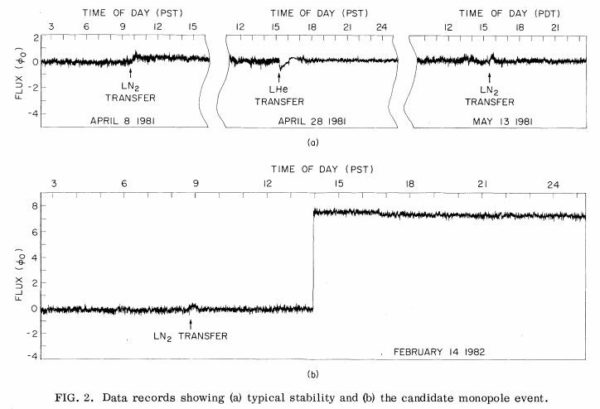 Image credit: Cabrera B. (1982). First Results from a Superconductive Detector for Moving Magnetic Monopoles, Physical Review Letters, 48 (20) 1378–1381.
Image credit: Cabrera B. (1982). First Results from a Superconductive Detector for Moving Magnetic Monopoles, Physical Review Letters, 48 (20) 1378–1381.
From Michael Kelsey on abandoning the magnetic monopole: "Blas Cabrera certainly has continued a strong and active career! I’m a member of both the CDMS and its successor, the SuperCDMS, Collaborations (cryogenic dark matter detectors), and Blas is heavily involved in the project, both the “big picture” and many details of the detector design."
One of the toughest things to do in life is abandon an idea, finding or even a paradigm-shifting discovery because subsequent data and evidence didn't hold up or pan out the way you had initially envisioned. That Blas Cabrera was able to cease his pursuit of magnetic monopoles when his findings failed to be reproduced is a testament to his willingness to embrace the full suite of scientific data out there. CDMS (and its successors) has set some of the most stringent limits on the interaction cross-sections of potential dark matter candidate particles, and Blas has been at the forefront of that.
But no one still knows how to explain that February 14, 1982 event. Perhaps no one in the Universe knows what happened that day.
The results of last week's Twitter poll. Via https://twitter.com/StartsWithABang/status/752282058420920320?ref_src=t….
From AC on the See Noevo question: "I don’t know why anyone wastes their time engaging him every time he makes a comment. It is such a waste of time and space and really takes away from what are usually otherwise great conversations in the comments."
A lot of people wanted this commenter banned; but it took a 2/3 majority to do it and we only got to 57%. So unless they ask a substantive question or make a compelling comment that's worth responding to, I won't be doing it any further. We can revisit the ban question if there's enough outcry, or if you want a better way to vote besides Twitter. (Which I chose because it was easy to setup, embed and use.)
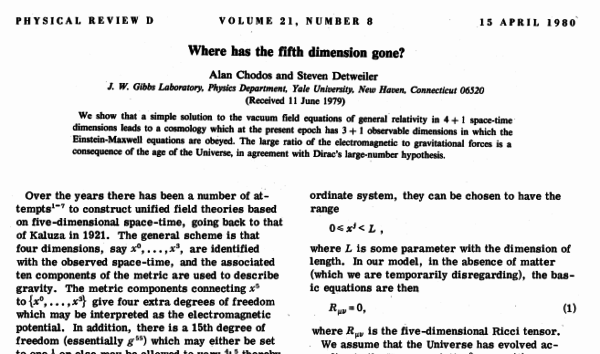 Chodos and Detweiler, PRD, 21, 8, 1980. Retrieved from http://www.physics.ufl.edu/~det/1980%20Chodos%20Det%20Where%20has%20the….
Chodos and Detweiler, PRD, 21, 8, 1980. Retrieved from http://www.physics.ufl.edu/~det/1980%20Chodos%20Det%20Where%20has%20the….
From Wow on collapsing extra dimensions: "I don’t know if anyone remembers, but a looong way back, I said that the inflation of the universe could have been “powered” by the collapse of the extra dimensions, as if it were a phase change with dimensions “freezing out”."
As far as I know, the original idea for something that would motivate this was a paper by Chodos and Detweiler back in 1980, submitted before Guth's inflation was ever conceived. What they found was that a generic 5D Kasner metric with one contracting dimension would lead to a 4D FLRW Universe (back before the "L", and possibly the "F" were included in that), which is the Universe we appear to live in. This was arguably the most important and influential paper for both Alan Chodos' and Steve Detweiler's careers.
Steve died of a heart attack earlier this year, and I was shocked when I learned of it. He was always incredibly healthy and athletic: a former wrestler and an excellent runner, and he was only in his 60s. He was also the professor who taught me General Relativity when I was in graduate school, and an incredibly kind, generous, and fair individual. If you can find the paper that connects this idea to the inflationary scenario, I'd be curious to take a look.
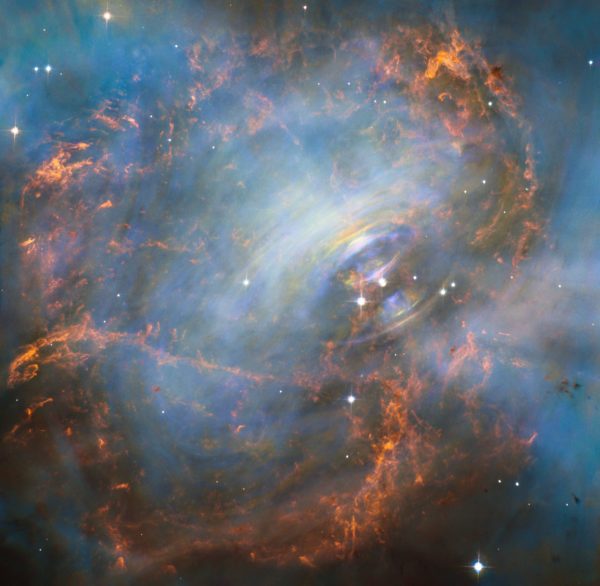 The highest-resolution image, taken in time-lapse in different colors, of the central region of the Crab Nebula. Image credit: NASA, ESA.
The highest-resolution image, taken in time-lapse in different colors, of the central region of the Crab Nebula. Image credit: NASA, ESA.
From PJ on... well, this picture: "That was an absolute jaw-dropper when I saw that on NASAs Astronomy Picture of the Day site for July 8. Not so long ago, we may not have been aware of the presence of the shock waves, and winds created. Our grasp and use of technology is advancing very well."
First off, if anyone doesn't know Astronomy Picture of the Day (APOD), I highly recommend bookmarking it. Second, the way this visible light image was constructed is fantastic:
- Hubble's incredibly high-resolution camera pointed at the central region of the Crab Nebula, where the pulsar is known to be located.
- It observed, for hours, that location using three different color filters.
- But because the colors were taken sequentially, you can see an "iridescent" effect near the very center, that looks a little like a soap bubble ripple.
This is because the motions internal to the pulsar itself are so fast that the material actually moves over the timespan that the different colors in the image were taken.
Distribution of Scattered Disk objects, with the latest object, 2015 RR245, added in by hand. Note that it is disputable whether this is a classical KBO or a scattered disk object. Image credit: Wikimedia Commons user Eurocommuter under a c.c.a.-s.a.-3.0 license.
From Denier on telescope time: "This rock was discovered by the Outer Solar System Origins Survey (OSSOS) project using the Canada-France-Hawaii Telescope and it brings up a question I’ve been curious about:
How is the telescope time paid for?"
"Paid for" isn't really applicable here. Nobody pays for the telescope time, which is to say you can't walk up to a telescope and say, "here's tens of thousands of dollars, now give me my observing night," and bump one of those freeloading freebie scientists. When telescopes are constructed, the decisions about who gets to use the telescope what percentage of the time are normally factored into the construction agreement. For the CFHT -- and for all telescopes constructed on Mauna Kea -- something like a mandatory 15% of the time goes to Hawaii residents, which includes people at the IFA and the University of Hawaii. The rest goes through other organizations that fund, support or otherwise manage the telescope: organizations like the NSF, AURA, the ESO and others.
But the question you should be asking is how is the telescope time allocated; there's no paying for time.
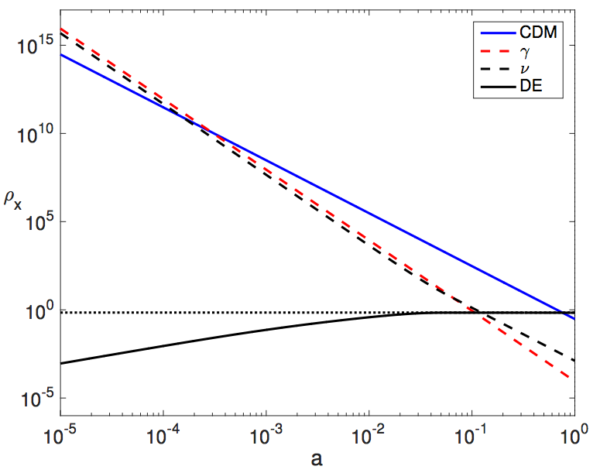 An illustration of how the radiation (red), neutrino (dashed), matter (blue), and dark energy (dotted) densities change over time. In this new model, dark energy would be replaced by the solid black curve, which is heretofore indistinguishable, observationally, from the dark energy we presume. Image credit: Figure 1 from F. Simpson et al. (2016), via https://arxiv.org/abs/1607.02515.
An illustration of how the radiation (red), neutrino (dashed), matter (blue), and dark energy (dotted) densities change over time. In this new model, dark energy would be replaced by the solid black curve, which is heretofore indistinguishable, observationally, from the dark energy we presume. Image credit: Figure 1 from F. Simpson et al. (2016), via https://arxiv.org/abs/1607.02515.
From Sean T on the definition of relativistic: "I believe that relativistic means that a particle has a total energy much higher than its rest energy, ie. mc^2. In practical terms, a relativistic particle is one that travels at an appreciable fraction of c. Neutrinos in normal circumstances certainly qualify as relativistic."
This is actually my preferred way to think about relativistic. If you move at a significant fraction of the speed of light, you're called relativistic because using Newtonian mechanics is insufficient to describe an object's motion; you need special relativity. The way to rule-of-thumb it is to take the particle's rest energy -- for neutrinos, it's between 0.003 eV and 0.08 eV or so -- and see whether the kinetic energy is above (relativistic) or below (non-relativistic) it.
For neutrinos made in stars, explosions, fusion reactions, etc., they're up at energies in the ~MeV range, enough to make them very, very relativistic. (When KE >> the rest energy, we call that ultra-relativistic.) But for neutrinos made in the Big Bang, they have a rest energy today of about 0.2 meV, or 0.0002 eV, meaning these relic, Big Bang neutrinos are highly non-relativistic today, moving at only a few hundred km/s.
You "freeze" when you go from relativistic to non-relativistic. Interestingly, the related concept of "freeze-out," or when an interaction becomes unimportant, is approximated very well by looking at when the thermal or kinetic energy of a system of particles drops below the rest energy of the interacting particles in question. This happens at many different instances in the expanding Universe.
Artist’s logarithmic scale conception of the observable universe. Image credit: Wikipedia user Pablo Carlos Budassi.
From GMcK on the original article: "By the way, I don’t go to Forbes.com — they embody the worst aspects of the capitalist web, with excessively intrusive, obnoxious ads that are hard to distinguish from malicious ones, stories broken into tiny pieces in order to artificially raise page views, and who knows what else. How about a link to the actual article by Simpson et al., or is that paywalled too? An arXiv link, maybe?"
Not going to Forbes.com is totally your prerogative. By default, they do break stories into tiny pieces, although if you've ever gone to one of mine, you'll notice mine are not broken up that way; I "unpaginate" the formatting whenever I can. The original Simpson et al. paper is linked from my Forbes piece, and on a 7 day delay, I'll publish the entire article ad-free on Medium.
Forbes pays me. Medium doesn't, and it's only by the grace of my Patreon supporters that I publish for free on Medium at all. If you want to be part of the solution, you can support me, too!
 Where the red Xs are, inflation comes to an end and we get a Big Bang, but there are more regions where inflation continues onwards (no X) than where it ends, and hence we get ongoing, unrelated Big Bangs. Image credit: E. Siegel.
Where the red Xs are, inflation comes to an end and we get a Big Bang, but there are more regions where inflation continues onwards (no X) than where it ends, and hence we get ongoing, unrelated Big Bangs. Image credit: E. Siegel.
From Denier on the Multiverse and very large numbers: "10^91!!! That is a lot, but it is a minuscule number compared to the 10^500 stable vacua states in the string theory landscape. When I first read that number I simply couldn’t wrap my head around it, but now I have a new standard candle. There are more possible solutions than there are particles in the universe by a long, long, loooooong margin.
When the numbers get that high, what even is the point of counting?"
I actually think you nailed it: when the numbers get too high for you to accurately wrap your head around, counting is the only way to accurately assess whether this is a reasonable line of pursuit.
It's easy to toss around words like "infinite" or "infinitesimal," but that's hyperbole. Be quantitative, and you'll actually be able to get an answer.
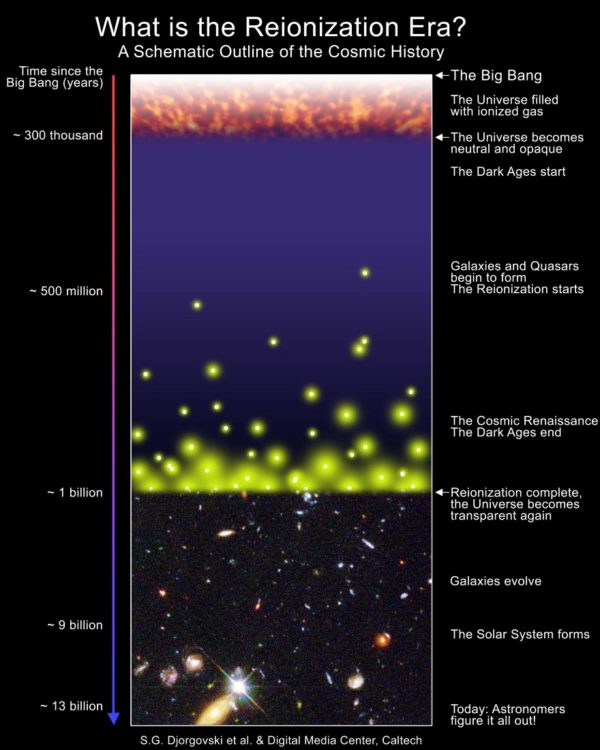 The reionization and star-formation history of our Universe. Image credit: NASA / S.G. Djorgovski & Digital Media Center / Caltech.
The reionization and star-formation history of our Universe. Image credit: NASA / S.G. Djorgovski & Digital Media Center / Caltech.
And finally, over on Forbes, Donghua Xu asked: "Even if there was no dark age, the visible lights back then would have red-shifted to invisible wavelength when they reach us today, as the Universe expands, right?"
If the Universe were always transparent, then redshift would be a very big deal. Our visible range of 400-700 nanometers means that we'd only be able to see visible light out to a redshift of about 0.75; beyond that, all the visible light would be shifted into the IR. But human eyes would be able to see light generated in the Ultraviolet (Lyman-alpha, Lyman-limit, etc.) out to a redshift of approximately 8; we are saved by the short-wavelength energies.
But beyond that, practically everything produced by stars would occur in the infrared, and human eyes couldn’t see it. That's the limit of what human eyes can see, and so it's very fortunate we go well outside visible light; our view -- even arbitrarily magnified -- is just too limited!
- Log in to post comments

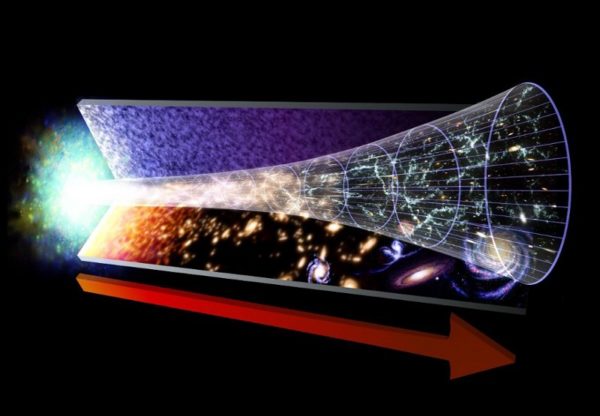
"As far as I know, the original idea for something that would motivate this was a paper by Chodos and Detweiler back in 1980,"
It's possible that's the one I remember. I went to uni late 1980s, and the paper was not "recent" then. That isn't the paper I've got the names of an author for.
PS, apologies for hitting send before typing this in, it was OKThen who was interested in what the paper was, but they're either not going to SWAB any more or are only going on the media.com/forbes area.
"He was always incredibly healthy and athletic: a former wrestler and an excellent runner, and he was only in his 60s."
Arhythmia can set in no matter what your fitness level. Lack of fitness only gives other reasons for heart failure.
One problem is the use of steroids to build muscle, so a lot of bodybuilters and professional (even semi-professional) athletes can die from heart attack because the heart is *over* developed from steroids.
Re: Forbes and complaints thereof.
If potential customers aren't going but don't get the opportunity to say why, the company will have no idea why they aren't getting more custmers and will try any old random shit to change things (usually screw current customers to "monetise" them more heavily).
By complaining the company gets a chance to see WHY, and can therefore decide whether they can do something different in a way that turns that potential customer into a real customer.
"Vote with your wallet" doesn't work. Mostly because the company cannot work out a strategy with no evidence other than "we're losing custom". Partly as well because anyone deciding to actually DO that (as opposed to taking the advice as "STFU and stop complaining" which is usually what "You can always vote with your dollar!" means) are vilified, ridiculed and told they should not be doing that.
Complaining is a necessary part of the free market. It's not just the customers that need to be fully informed, but the businesses too.